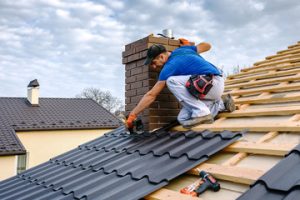Roof damage can appear unexpectedly after heavy weather. Small leaks often turn into bigger problems quickly. Ignoring early signs may lead to costly repairs. Timely attention can save both money and stress.

Inspecting your roof regularly prevents hidden damage. Missing shingles, loose nails, or worn-out flashing are warning signs. Even minor issues allow water to seep in. Catching problems early maintains the roof’s integrity.
Understanding your roof’s material is crucial before repairs. Different materials require distinct techniques. Some surfaces are more prone to cracking. Using improper methods can worsen the damage.
Water stains on ceilings often signal a roof leak. These stains should never be ignored. Moisture weakens structural components over time. Repairing leaks promptly avoids larger structural damage.
Ice and frost can worsen roof conditions during cold seasons. Ice dams trap water on the surface. This can lead to leaks and insulation problems. Preventative care is essential in regions with fluctuating temperatures.
A professional inspection identifies subtle damage. Some issues are invisible from the ground. Technology like infrared cameras can detect hidden moisture. Early detection helps in planning effective repairs.
Roof repair is not only about fixing leaks. It also involves reinforcing structural safety. Strengthening weak points extends the roof’s lifespan. Preventive reinforcement is cheaper than full replacement.
Temporary patches are useful in emergencies. They stop water from entering immediately. However, these should not replace permanent solutions. Scheduling proper repairs ensures long-term protection.
Choosing the right sealants and adhesives is vital. Not all products perform well under intense weather. High-quality materials prevent premature deterioration. Always follow manufacturer guidelines during application.
Ventilation plays a critical role in roof health. Poor airflow traps heat and moisture. This accelerates material degradation. Adequate ventilation prevents mold and structural issues.
Flashing around chimneys, vents, and skylights often fails first. Water can seep through these small gaps. Replacing or sealing flashing prevents leaks. Neglecting this can compromise the entire roof system.
Gutter maintenance complements roof repairs. Blocked gutters cause water to back up. Overflowing water seeps under roofing layers. Cleaning gutters regularly protects the roof and foundation.
Sun exposure gradually weakens roofing materials. UV rays break down shingles over time. Faded or brittle surfaces indicate aging. Addressing these issues delays costly replacements.
Roof repairs are more complex on steep surfaces. Safety measures are necessary to prevent accidents. Harnesses and scaffolding may be required. Professional expertise ensures both safety and quality.
Storms can lift shingles and damage underlayers. Immediate repair prevents water penetration. Insurance coverage may assist in such cases. Prompt action minimizes both repair time and cost.
Leaks around skylights are common and often tricky. Seals can crack or wear over time. Resealing prevents leaks and water damage. Proper installation ensures they remain waterproof for years.
Moss and algae growth degrade roofing materials. These organisms retain moisture and cause decay. Cleaning the roof prevents further damage. Treating affected areas extends the roof’s life.
Roofs with multiple layers often need careful assessment. Adding new layers can add weight stress. Sometimes complete replacement is more effective. Evaluating the structure avoids future collapse.
DIY repairs can be tempting but carry risks. Mistakes may worsen leaks or void warranties. Professionals bring experience and the right tools. Their work ensures durability and safety.
Emergency repairs often use tarp coverings. Tarps block rain until proper fixes are done. They are a temporary shield, not a final solution. Quick action reduces interior water damage.
Proper insulation beneath the roof improves repair effectiveness. Insulation prevents condensation and heat loss. Damp or damaged insulation should be replaced. This enhances both comfort and structural integrity.
Regular roof maintenance extends lifespan and prevents surprises. Seasonal inspections catch minor issues early. Small fixes prevent major expenditures later. A proactive approach saves time and money.
Roof repair may uncover hidden structural damage. Rotten wood or weakened supports often require attention. Addressing these promptly prevents collapse. Safety should always be the priority.
Fasteners and nails can loosen over time. Loose attachments reduce shingles’ ability to stay in place. Tightening or replacing them improves stability. Small hardware checks prevent large-scale damage.
Storm debris like branches and leaves can puncture roofs. Removing debris quickly avoids scratches and holes. Debris often hides further damage beneath. Routine cleaning ensures longevity.
Modern roofing materials offer improved durability. Synthetic options resist cracking, fading, and water damage. Investing in advanced materials reduces maintenance. Longevity saves money in the long run.
Color and coating affect the roof’s performance. Reflective coatings reduce heat absorption. This helps protect roofing materials from early wear. It also improves indoor comfort and energy efficiency.
Repairing roof edges prevents wind damage. Edges are exposed to harsh weather first. Reinforcing edges keeps the entire roof intact. Small measures prevent widespread deterioration.
Flashing joints need careful sealing after repairs. Improperly sealed joints lead to recurring leaks. Using high-quality sealants ensures longevity. Attention to detail prevents future problems.
Chimney flashing often deteriorates first. Water can seep behind masonry. Replacing old flashing protects both chimney and roof. Proper alignment ensures efficient drainage.
Regular inspections after storms prevent unnoticed damage. Strong winds lift shingles and expose underlayers. Repairs soon after storms reduce long-term issues. Insurance claims are easier with documented evidence.
Roofs require both internal and external checks. Interior leaks indicate underlying issues outside. External inspections verify shingles, flashing, and drainage. Combining both methods ensures comprehensive care.
Repairing valleys prevents water accumulation. Valleys are natural channels for rainwater. Any obstruction leads to pooling and leaks. Maintaining valleys ensures proper drainage flow.
Severe weather may expose roofing weaknesses. Extreme heat, wind, or hail accelerates deterioration. Quick repairs prevent secondary damage. Weather-resistant upgrades strengthen the roof.
Every repair should consider long-term prevention. Temporary fixes may be necessary but are not enough. Reinforcing weak areas ensures durability. A planned approach minimizes repeated work.
Choosing a qualified contractor is essential. Experience, tools, and safety protocols matter. Proper assessment avoids unnecessary repairs. Trust ensures both quality and efficiency.
Roof repairs protect more than the building. They safeguard furniture, insulation, and interior finishes. Water damage can spread quickly if ignored. Repairing promptly maintains overall property health.
Some repairs require replacing entire sections. Partial fixes might not be sufficient for advanced damage. Complete replacement ensures uniformity and strength. It prevents future patchwork issues.
Weatherproofing materials improve repair outcomes. Advanced sealants resist water, wind, and UV exposure. Protective coatings prolong life and reduce maintenance. Choosing durable options ensures lasting protection.
Regular maintenance reduces emergency repairs. Preventive inspections catch problems before they escalate. Scheduling checks after extreme seasons is ideal. Consistent care keeps the roof functional and secure.
Repairing older roofs may reveal outdated construction. Some materials no longer meet current standards. Upgrading ensures safety and performance. Modern techniques improve resilience and reduce future costs.
Ridge and hip caps require attention during repairs. They seal roof peaks and prevent water infiltration. Properly installed caps maintain structure integrity. Neglecting these weak points leads to leaks.
Minor repairs often prevent major structural damage. Replacing damaged shingles, sealing leaks, and clearing gutters are essential. These small steps save large expenses later. Roof longevity depends on consistent care.
Roofs are investments in home protection. Timely repairs maintain value and safety. Ignoring damage risks higher future costs. Proper upkeep ensures comfort and security.
